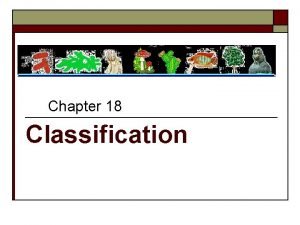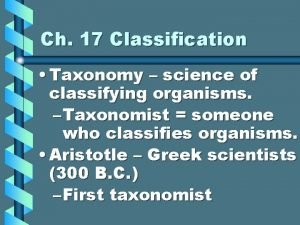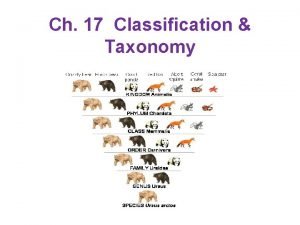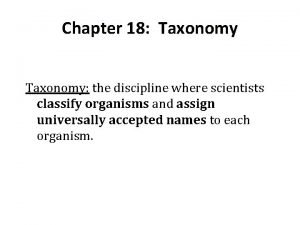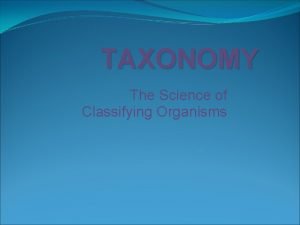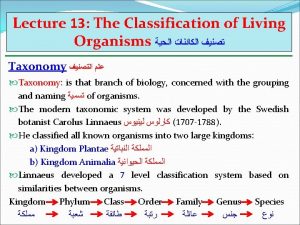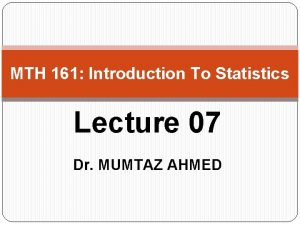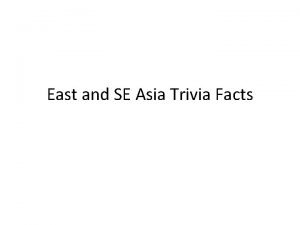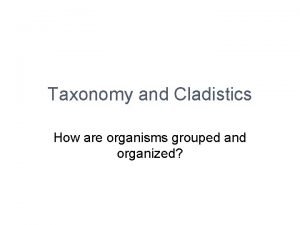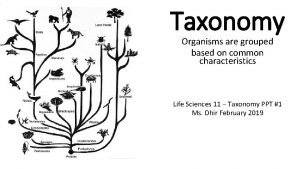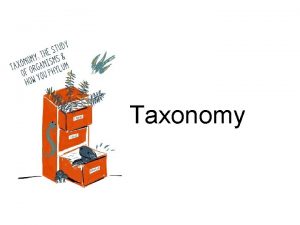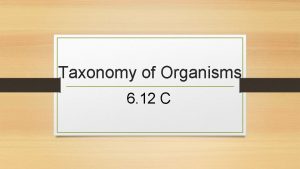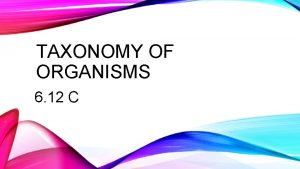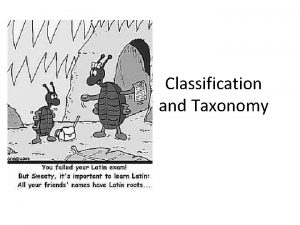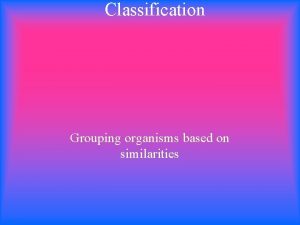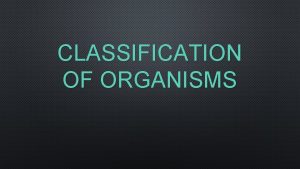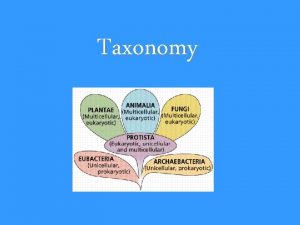Taxonomy how organisms are grouped Taxonomy Discipline of


























- Slides: 26

Taxonomy – how organisms are grouped

Taxonomy Discipline of classifying organisms and assigning each organism a universally accepted name. Defined: In other words, naming things.

Why common names don’t work Common names vary among languages. Example: United Kingdom – Buzzard refers to a hawk United States – Buzzard refers to a vulture Red-tailed Hawk Honey Buzzard Turkey Vulture

History • Aristotle – grouped organisms by basic characteristics – Ex blood or no blood • Scientists would describe the appearance of an organism in great detail. – Very long process • Modern naming of animals – Carolus Linnaeus

Carolus Linnaeus (1707 – 1708) • Created the system of naming we use today. – Developed Binomial Nomenclature (a system that used 2 latin words to describe an organism. – The First word is the GENUS of the organism. – The second is the SPECIES of the organism. • In taxonomy, a group or level of organization is called a taxonomic category or taxon.

Using your name, what would be your name in Binomial nomenclature? • Ex: Mrs. Beard’s first name is Amy, so her scientific name is – Beard amy • Yours:

Example of Binomial Nomenclature • Polar Bear is Ursus maritimus • Ursus: genus Ursus contains 5 other kinds of bears • maritimus: species The Latin word, maritimus, refers to the sea. Polar bears often live on pack ice that floats in the sea.

Examples of Binomial Nomenclature • Polar Bear = Ursus martimus • Grizzly Bear = Ursus arctos horribilus • Black Bear = Ursus americanus

In addition to Genus and Species, each organism has other categories it can belong to. These categories are called TAXA(plural) or TAXON (singular)

Each organism has its own… Domain Kingdom Phylum Class Order Family Genus Species

How to remember: Da King Phillip Came Over For Green Salad Domain Kingdom Phylum Class Order Family Genus Species

Definitions to know • Species: group of similar organisms that can breed and reproduce • Genus: group of closely related species

• Family: Family Group of genera that share many characteristics • Order: Order Group of similar families • Class: Class Group of similar orders • Phylum: Phylum Group of closely related classes • Kingdom: Kingdom Largest taxonomic group, consisting of closely related phyla.

Here We Go… Polar Bear Species: maritimus Genus: Ursus Family: Ursidae Order: Carnivora Class: Mammalia Phylum: Chordata Kingdom: Animilia Domain: Eukarya What do these mean? . . . lets see

What they mean Species: maritimus (lives in marine environment) Genus: Ursus (kind of bear) Family: Ursidae (larger category of bears) Order: Carnivora (meat-eating animals) Class: Mammalia (warm-blooded, hair, & milk) Phylum: Chordata (vertebrates) Kingdom: Animilia (there are 6 kingdoms)

Phylum Chordata Class Mammalia Order Carnivora Family Ursidae Genus Ursus Species maritimus


For humans…this is their taxonomic classification: • Domain: Eukarya • Kingdom: Animalia • Phylum: Chordata – Subphylum: Vertebrata • • • Class: Mammalia Order: Primate Family: Hominidae Genus: Homo Species: sapiens

Ways to identify organisms • Dichotomous Key – Statements that describe organisms to help identify them – Always start with the first 2 statements • Cladogram – A diagram that shows the evolutionary relationships among a group of organisms.


Classification Using Cladograms

Crustaceans Gastropods Molted Exoskeleton Segmentation Free swimming Larva Using Cladograms, you can see that crabs and barnacles share similar characteristics because they both molt & are segmented


Where do viruses go? Viruses: Are particles of nucleic acid, protein, and in some cases lipids that can reproduce ONLY by infecting living cells. Viruses are made of a core of either DNA or RNA surrounded by a protein coat. These are T 4 Bacteriophage A bacteriophage is a virus which infects bacteria

Where do viruses go? (continued) Viruses are not considered alive because they don’t have ALL the characteristics of life. Example: They can’t reproduce independently These are the Influenza Viruses Influenza or "flu" is an infection of the respiratory tract that can affect millions of people every year.

The End.
 Antigentest åre
Antigentest åre Kingdom animalia cladogram
Kingdom animalia cladogram Discipline of classifying and naming organisms
Discipline of classifying and naming organisms The scientific discipline of classifying organisms
The scientific discipline of classifying organisms What is the hierarchical system used to classify organisms?
What is the hierarchical system used to classify organisms? Discipline of classifying and naming organisms
Discipline of classifying and naming organisms The scientific discipline of classifying organisms
The scientific discipline of classifying organisms Organism
Organism Why do organisms interact with other organisms
Why do organisms interact with other organisms Organisms taxonomy
Organisms taxonomy Dear king phillip came over
Dear king phillip came over Taxonomy in biology
Taxonomy in biology Levels of classification
Levels of classification Taxonomic classification
Taxonomic classification Name of organisms
Name of organisms Marzano taxonomy verbs
Marzano taxonomy verbs Merits and demerits of concurrent deviation method
Merits and demerits of concurrent deviation method How are plants grouped
How are plants grouped How to find percentile rank
How to find percentile rank Grouped frequency table
Grouped frequency table Decile formula
Decile formula Cell to tissue to organ to organ system to organism
Cell to tissue to organ to organ system to organism Grouped frequency diagram
Grouped frequency diagram Arithmetic mean for grouped data
Arithmetic mean for grouped data Arithmetic mean ungrouped data examples
Arithmetic mean ungrouped data examples Xi river map
Xi river map Central tendency of grouped data
Central tendency of grouped data

